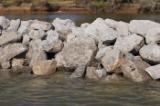The Mad Island Shoreline Protection Project by Jeff Raasch and Matt Nelson
The Mad Island wetlands are important nursery grounds for recreationally and commercially important aquatic species including shrimp, finfish, and crabs. For decades, staff with the Texas Parks and Wildlife Department have watched the shoreline of the Great Intercoastal Waterway retreat at a rate of approximately 1 to 3 feet annually due to boat and barge wake action. When the waterway was originally dredged, in the early to mid-1940s, it was approximately 100 feet wide. Currently, the waterway along the Mad Island Wildlife Management Area boundary is more than 300 feet wide. More than 1,000 acres of coastal marsh with surrounding prairie are threatened by the erosion. Along with changing salinity and hydrologic regimes in the marshes, waves also wash out organic matter in the marsh soils thereby reducing their ability to support plants. As the vegetation dies due to increased salinity gradients and lack of organic matter, the soils become vulnerable to further erosion.
The completed Mad Island Shoreline Protection Project provides an offshore rock breakwater parallel to the existing shoreline for a distance of approximately 1.8 miles along the most sensitive portion of the shoreline. The breakwater was placed off the existing shoreline to maximize marsh development behind the structure while realizing a cost savings based on the shallow depth of the water in relation to the necessary construction height of the breakwater. The breakwater is composed of 100 percent C Stone (400 lb) at an average height of 3.5 feet with a 4-foot crown and a slope of 2.5 feet. The completed project creates a permanent offshore breakwater that substantially reduces wave energy along the GIWW shoreline of Mad Island and stabilizes the shoreline from further erosion. The breakwater protects the adjacent inland marshes and freshwater ponds from further saltwater intrusion and wetland habitat loss. The project also provides an area between the offshore breakwater and the current shoreline for future re-establishment of intertidal emergent marsh habitat through the natural build up of suspended sediment through the rocks or carried over the breakwater by tides or waves. A healthy and well-established marsh will further enhance the effectiveness of the breakwater structure.
This project represents many years of effort by key agency and partner staff to finally see this project to completion. The majority of the funding came from a successful grant from the Coastal Impact Assistance Program (CIAP). But a special thank you goes to the Texas Chapter of The Nature Conservancy and especially Mark Dumesnil. This project would not have been completed without Mark's long-term commitment to the project. He is truly a dedicated conservationist.
Jeff Raasch is the wetland and joint venture project leader for TPWD working out of Austin. Matt Nelson is CCWEP working out of Bay City.







